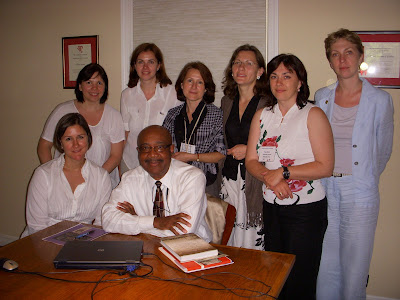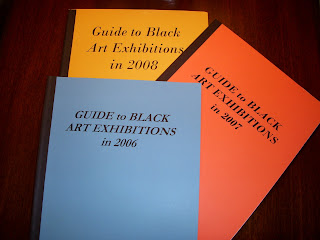 On June 8, 2009, George was involved with a Congressional funded program through the Open World Leadership Center that included representatives from various types of libraries in Russia. This project was proposed and led by Kristen Regina, Host Coordinator and Head Librarian at the Hillwood Estate, Museum and Gardens (Washington, DC). The goal of this program was to help art librarians create a broader audience by incorporating the study of specialized art libraries with general and public libraries, ultimately crossing the border of traditional art readership to inspire new readers. George, as an art librarian, was involved because of the successful grass root strides that he has made in documenting the efforts and accomplishments of black (African American) artists through the publication of the Guide to Black Art Exhibitions.
On June 8, 2009, George was involved with a Congressional funded program through the Open World Leadership Center that included representatives from various types of libraries in Russia. This project was proposed and led by Kristen Regina, Host Coordinator and Head Librarian at the Hillwood Estate, Museum and Gardens (Washington, DC). The goal of this program was to help art librarians create a broader audience by incorporating the study of specialized art libraries with general and public libraries, ultimately crossing the border of traditional art readership to inspire new readers. George, as an art librarian, was involved because of the successful grass root strides that he has made in documenting the efforts and accomplishments of black (African American) artists through the publication of the Guide to Black Art Exhibitions. It was an enlightening and engaging experience for the visiting delegation, as well as the presenter and the American host. George demonstrated in his talk/presentation how the Guide to Black Art Exhibitions evolved as a publication, focusing on the use of technology and particularly the Internet to explore new ground in discovering untapped information and culling it together into some meaningful way to create the annual Guide. Further discussions centered on a marketing strategy that included how to reach out to a broad audience via simple and low-cost means such as email and the web.
Although, the topic was not based on Russian culture or history, the template used for the success of the Guide could be replicated in any culture. There was engaging dialogue during and after the presentation. This was yet another way to develop a network of contacts between Russian and US art librarians for professional collaboration, problem solving, and possible future joint research.
The delegation was presented copies of the Guide to Black Art Exhibitions and they presented George with a copy of Alexander Pushkin's In Hopes of Fame and Bliss to Come.
© 2009 Black Art Project... all rights reserved. For permission to reproduce contact: blackartproject@comcast.net.
